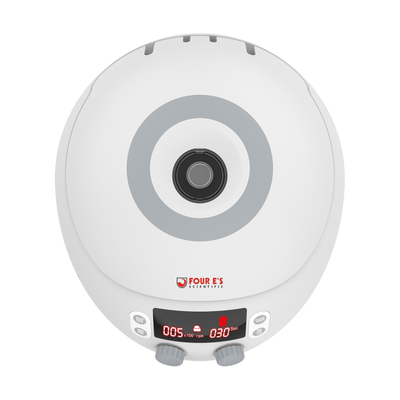

Views: 317 Author: Site Editor Publish Time: 2022-06-21 Origin: Site








Tips for Choosing the Right Centrifuge for your Lab
Centrifuges are vital devices in any Life Science Laboratories, be it for Research or Clinical Diagnostics laboratories. Centrifuges have wide use in clinical diagnostics, including clinical chemistry, clinical microbiology, hematology, etc. A centrifuge is a key tool in life science research and has applications in all fields including cellular biology, microbiology, molecular biology, biochemistry etc.
Selecting the right centrifuge for your applications.

Centrifuges are used mainly for separation of components in samples. The centrifugal force makes the molecules with greater density move toward the outer edges, while the smaller particles are moved towards the center.
The key factors to consider before selecting a centrifuge are:
Centrifuge Speed or RPM Range (RCF is also critical in many protocols): Centrifuge speeds are represented in RPM (Revolutions per Minute). You need to know what the speed requirement for your specific application is. Relative Centrifugal Force (RCF) is more critical to certain protocols than RPM. RCF is the force exerted on the inside of the rotor due to its rotation, represented as times gravity (×g), and is dependent on the rotor radius and the rotor speed. Centrifuge Manufacturers always mention the maximum values for RPM and RCF, and most of the models in the market can switch between RPM and RCF settings. RPM/RCF and centrifugation times are the key factors for any protocols.
Rotor Capacity & Type: Most centrifuges in the market comes available with multiple rotor options, providing flexibility to the customers. Knowing the maximum individual tube capacity and the number of tubes a rotor can hold is the starting point in rotor selection. Manufactures normally mention the rotor capacity in terms of the largest tubes it can hold and the number of tube slots available. The largest individual tube capacity needs to match the tube volume you are using. Most rotors also come with adaptors to hold smaller capacity tubes.

Also, centrifuge comes in a fixed-angle rotor design or a swing-out rotor design. In the fixed-angle rotor the tubes are maintained at a fixed angle through the centrifugation. A swing-out rotor has a variable angle and tubes are placed in tube-holders (or buckets) that are free to swing out. In a swing-out rotor the tube holders become horizontal during centrifuging (in short the direction of the centrifugal force aligns with the position of the tubes). Theoretically for pelleting applications, a swing-out rotor can provide better sedimentation as the pellets will form at the bottom of the centrifuge tube, whereas in a fixed angle rotor the sedimentation is more towards the sides of the conical bottom tubes.

But fixed rotors owing to their rigid design can withstand more centrifugal force and are thus preferred for high-speed molecular biology applications involving the separation of macromolecules like Nucleic Acids and Proteins. Swing-out rotors are normally preferred in low-speed applications where samples are to be resolved in density gradients, like PRP-PRF-CGF separations. Swing-out rotors also offer greater flexibility owing to wide selection of holders/buckets and adaptors.
Cooling Requirement: If your application is temperature sensitive, and requires precise temperature control, a refrigerated centrifuge needs to be used. During centrifuging heat is generated by the rotors at higher RPMs. There are mainly two mechanisms to lower this heat. One is through ventilation and the other is through refrigeration. A Ventilated centrifuge draws air into the chamber and expels air out there by cooling the chamber and preventing overheating. A refrigerated centrifuge on the other hand using cooling system to keep the centrifuge chamber at a set temperature. For normal applications a ventilated centrifuge is used due to its lower cost and smaller lab space requirement (refrigerated centrifuges are bulkier and expensive).
Based on these factors lab centrifuges can be categorized as follows:
Type | RPM range | Rotor Type | Capacity | Typical Applications |
Low-Speed Centrifuges (like Mini Centrifuge, Clinical centrifuge) | 4,000 - 6,000 rpm | Fixed angle or swing-out type | Mini Centrifuge: 6*2ml tubes or 16 PCR tubes Clinical Centrifuge: 8 tubes of 15ml (if fixed angle) OR Up to 4 ~ 6 tubes with capacity of 50mL (swing-out) | Biological Samples: cellular materials, blood, urine, sperm etc. Clinical Applications: PRP, PRF, lipid cell separation & stem cell isolation. Also, for low-speed centrifugation of microplates |
Hematocrit Centrifuge (Hematology) | 10,000 -14,000 rpm | Special Hematocrit Rotors | 24 capillary tubes | provides hematocrit values that can be used for testing in biochemistry, and other general clinical tests |
12,000 -15,000 rpm | Fixed Angle Rotors | 0.2ml to 2 ml tubes or PCR strips | Separation of macromolecules like Nucleic Acids, Proteins, Pelleting, Extractions, Purifications, Concentrations | |
High Speed Centrifuge | 15,000 - 30,000 rpm | Fixed Angle and Swing-Out Rotors | Rotors and adapters can handle PCR tubes/strips (0.2 ml), to centrifuge tubes up to 5 ml (12 tubes) | biochemical applications requiring a high speed of operations |
Ultra-Centrifuges | Up to 150,000 rpm | Fixed Angle and Swing-Out Rotors | separation of much smaller molecules like ribosomes, proteins, and viruses |
Safety: Another key factor while selecting a centrifuge are the safety features. This includes door interlocking system to prevent accidental opening, aerosol-tight rotors with lids for handling bio-hazardous substances, overspeed detection etc.
Please check our centrifuge section of our website to choose from our centrifuge range. If you need help to select the right centrifuge for your lab our specialists are always there to help. We also offer OEM/Custom Solutions to meet your requiremnts. Please Contact us.
content is empty!